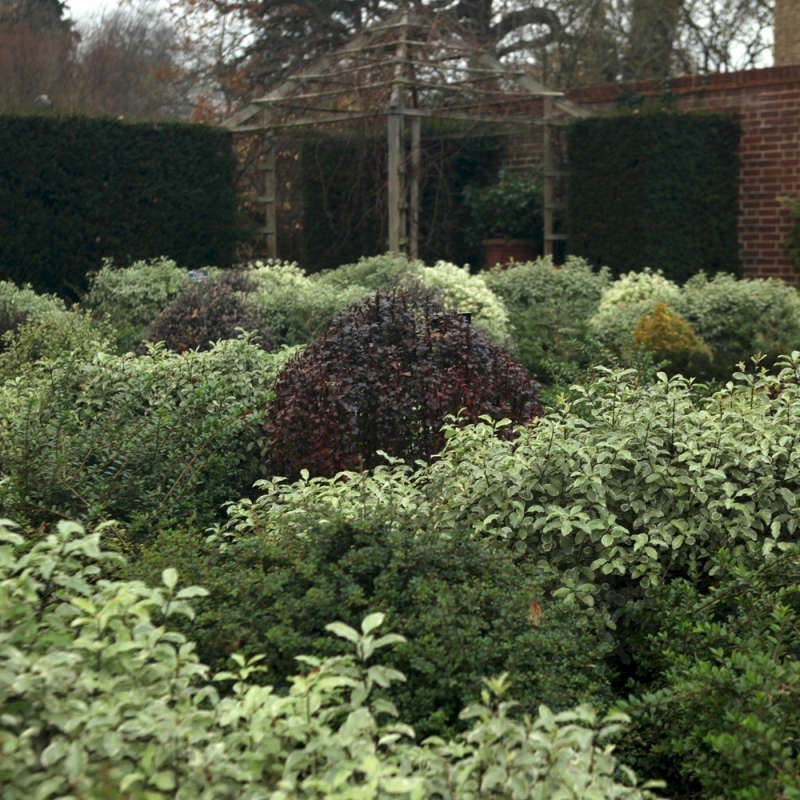A designer’s trick to assess the form of a landscape is to take a picture in black and white. In this monochrome image, the bones of a garden are thrown into sharp relief, reducing it to structure, texture, and tone. When the froth of summer disappears and the color has drained away, the success of a design rests in the combination of these forms. It’s why some gardens retain their magic in winter—a beauty that’s often ramped up when covered in shimmering frost or a dusting of snow.
It’s an idea highlighted by Piet Oudolf in his book Designing with Plants: “The sensitive gardener will observe that there are many more stages in the life of a perennial that are deserving of study and appreciation than simply the flowers—buds, unfurling leaves, seedheads, autumn foliage, winter’s skeletal remains… A good planting should have enough variety of shape to look interesting in a black and white photograph.”
And it’s a subject that photographer Andrew Montgomery has explored in depth in his first book, Winter Gardens, which he has produced and self-published with Clare Foster, an editor at House & Garden magazine.
Photography by Andrew Montgomery from Winter Gardens.

The mostly monochrome tome takes us through some familiar gardens—Piet Oudolf’s Hummelo in the Netherlands; Dan Pearson’s garden at Hillside in Somerset; Great Dixter; the grand Dorset estate Mapperton; as well as lesser known private gardens. And while Montgomery’s images showcase the exquisite beauty of these spaces in the dead of winter, often frozen or lightly shrouded in a gauzy mist or snow storm, Foster takes us through the elements that can make the winter garden sing.

For Pearson and Oudolf, stately perennials that retain their form through the winter are the stars; there are the graceful spires of Veronicastrum virginicum, spiky echinops, the distinctive seedheads of Echinacea purpurea or Baptisia australis as well as umbellifers such as Eupatorium maculatum and, Pearson’s favorite, giant fennels. All of these perennials stand through the colder months and bring intriguing shapes to the winter scene.

Grasses are amongst their stalwarts, too, and Foster helpfully highlights some of the most useful: the bleached-out columns of Calamagrostis x acutiflora ‘Karl Foerster’, the stunning plumes of Miscanthus sinensis varieties, arching Molinia caerulea as well as panicums and pennisetums. All are showcased at the Sussex Prairies garden where ornamental grasses are dotted about amongst the perennials and placed to be backlit by the low winter sun.

In more formal and classical gardens it’s trained trees and topiary that put on the stunning winter display. In a Tudor manor garden in Hampshire, a knot garden and labyrinth have been created from a blank canvas over the past three decades and are based on original drawings created by the 17th century architect Robert Smythson. Elsewhere in this extraordinary garden, yew is clipped into architectural hedges and playful shapes.

At Broughton Grange, in a garden designed by Tom Stuart Smith two decades ago, there are imposing copper beech beehives, pleached lime trees and tunnels of trained beech. All of which bring an ethereal beauty in winter as the cold descends. The idea is more relaxed at Great Dixter, where yew topiaries are dotted across the lawn tightly clipped and awaiting the first dusting of frost.

Unsurprisingly, within weeks of publication, Winter Gardens sold out of its first print run; it’s now being reprinted (£45, montgomerypress.co.uk). Limited edition prints from the book are also available.
For more on Great Dixter, see:
- Garden Visit: Great Dixter’s Warmth in Winter
- Jungleland: The Exotic Garden at Great Dixter
- Required Reading: Meadows at Great Dixter and Beyond
For more on Piet Oudolf, see:
- 10 Garden Ideas to Steal from Superstar Dutch Designer Piet Oudolf
- Designer Visit: Piet Oudolf’s Otherworldly Garden at Hauser & Wirth Somerset
- Landscape Ideas: 8 Favorite Gardens by Dutch Designer Piet Oudolf
- Five Seasons: The Gardens of Piet Oudolf
- High Line NYC: The Inside Story by Landscape Designer Piet Oudolf




Have a Question or Comment About This Post?
Join the conversation